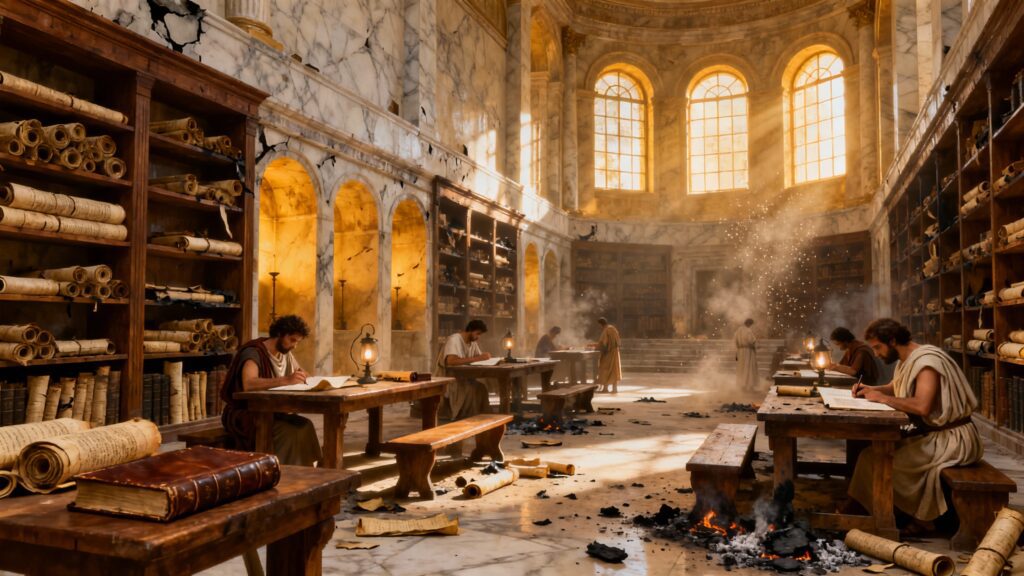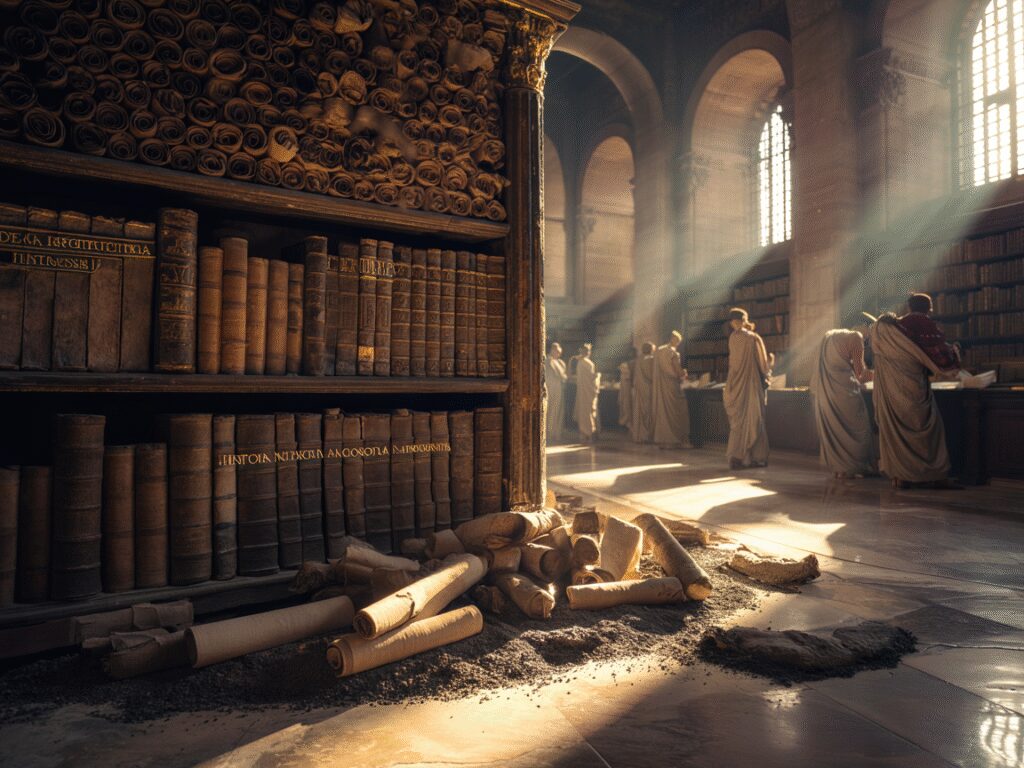Rome’s Lost Libraries—What Happened to the Knowledge Vaults of Antiquity? invites you to explore a profound mystery of history: the disappearance of ancient Roman libraries. These libraries were more than mere buildings; they were vibrant centers of culture and knowledge, holding thousands of scrolls that captured the intellectual achievements of antiquity.
Ancient Roman libraries served as vaults preserving philosophy, science, literature, and law—cornerstones of Western civilization. Their loss represents not only a tragedy for historians but also a cautionary tale about the fragility of cultural heritage.
Understanding what led to the disappearance of these antiquity knowledge vaults offers valuable lessons for modern efforts in preserving knowledge today. The story behind Rome’s lost libraries is a key to appreciating how civilizations can protect or lose their intellectual legacy across time.

The Grandeur of Ancient Roman Libraries
Roman libraries were grand places of knowledge, showcasing the empire’s intellectual ambition and cultural wealth. Among them, Trajan’s Forum library was a remarkable achievement, housing an estimated 20,000 scrolls carefully divided between Latin and Greek texts. This division highlighted Rome’s appreciation for both its native literary traditions and the classical heritage inherited from Greece.
The Villa of the Papyri in Herculaneum preserved approximately 1,800 scrolls, many of which survived the catastrophic eruption of Mount Vesuvius in 79 AD by being carbonized yet intact. These scrolls offer a rare glimpse into private collections of Roman elites and their scholarly pursuits, emphasizing the importance placed on literary accumulation beyond public institutions.
Architecturally, these libraries were designed to serve both preservation and study purposes:
- Reading chambers: Quiet spaces where scholars could engage deeply with texts.
- Alcoves lined with shelves: Organized storage that facilitated easy access while protecting fragile papyrus scrolls.
- Use of durable furniture and containers aimed to shield scrolls from moisture and decay.
Such features underscored a sophisticated approach to managing vast Roman scroll collections, blending functionality with reverence for written knowledge.

Public Access to Knowledge: The Functionality of Roman Libraries
Ancient Roman public libraries functioned primarily as custodians of knowledge rather than lending institutions. Unlike modern libraries where borrowing books is common, public libraries in Rome focused on safeguarding authoritative texts for study and consultation within their premises. Scrolls and codices were valuable and fragile, so strict policies limited their removal.
Key features of how these libraries operated include:
- Browsing Texts: Patrons could browse collections freely within reading rooms or alcoves. This access allowed scholars and citizens to engage directly with materials, fostering intellectual exchange.
- Restricted Lending: Lending policies were restrictive; scrolls rarely left the library. This preserved the integrity of texts but also meant knowledge dissemination relied heavily on personal visits.
- Scholars’ Spaces: Many scholars rented nearby rooms or shops to store personal collections or copied works. These rented spaces complemented public libraries by providing private areas for extended research.
- Supervised Use: Library attendants often monitored use to prevent damage or theft, balancing access with preservation.
This approach reflects the role of public libraries in Rome as guardians of cultural heritage—acting more like secure vaults than lending houses. Browsing privileges provided a controlled environment where learning flourished without compromising the precious texts.
Understanding these dynamics sheds light on Rome’s Lost Libraries—What Happened to the Knowledge Vaults of Antiquity? It reveals a system designed for preservation that ultimately faced challenges beyond policy—natural disasters and neglect—that led to the tragic loss of invaluable works. Such losses resonate with the fate of many ancient libraries, including those that would make any book lover drool, as seen in this exploration of ancient libraries. Moreover, the preservation methods employed in these libraries can be further understood through resources like this guide on archival practices.

From Catastrophe to Cultural Tragedy: The Losses Sustained by Roman Libraries
The fate of ancient Roman libraries, a significant part of the broader history of libraries, was sealed not by a single monumental disaster but through a series of localized calamities and ongoing neglect. One of the most devastating incidents was the destruction by fire in Rome, 192 CE, which obliterated countless rare texts. Among these losses were the invaluable medical notes of Galen, a towering figure in ancient medicine whose works shaped medical knowledge for centuries. His personal library, containing drafts and ongoing research, vanished in flames, representing an irreplaceable cultural and scientific loss.
Vulnerability to Fires
Roman libraries were especially vulnerable to fires due to their construction materials and dense urban settings. Unlike the legendary destruction of Alexandria’s library — often imagined as one cataclysmic event — Rome’s knowledge vaults suffered repeated damage from smaller-scale disasters such as:
- Urban fires spreading rapidly through wooden shelves and papyrus scrolls
- Earthquakes causing structural collapses
- Political turmoil leading to neglect or intentional destruction
The Role of Neglect
Neglect also played a significant role. Without sustained maintenance or systematic copying programs, texts succumbed to decay. Papyrus scrolls were fragile and prone to deterioration in humid environments, accelerating loss over time.
This patchwork erosion of collections turned Roman libraries into cultural tragedies where treasured literary, philosophical, and scientific works slipped beyond recovery, leaving gaps in historical understanding that persist today.

Survival Amidst Ruins: Preserving What Remains of Rome’s Literary Legacy
The discovery of the Herculaneum papyri is a remarkable testament to the endurance of ancient knowledge. Buried under volcanic ash from Mount Vesuvius in 79 AD, the Villa of the Papyri preserved roughly 1,800 carbonized scrolls. These fragile documents reveal lost works of philosophy and literature, especially those connected to Epicurean thought. Advanced imaging techniques continue to unlock readable fragments, allowing scholars to piece together texts once thought forever destroyed.
In addition to Herculaneum, significant collections known as the Oxyrhynchus papyri emerged from archaeological excavations in Egypt. This trove of thousands of manuscripts covers a broad spectrum—classical literature, early Christian writings, official records—providing a wider lens on the intellectual world that intersected with Roman culture. The survival of these texts underscores how climatic conditions and burial environments contributed to preservation far beyond Italy’s borders.
Roman efforts to combat the inherent fragility of papyrus involved transitioning key works onto parchment. This more durable medium resisted decay better and became preferred for important texts over time. Copying onto parchment was not just practical but essential for safeguarding literary heritage amid repeated threats of fire and neglect. Such conservation methods helped maintain continuity in transmitting knowledge despite losses suffered by original scroll collections.
Key Takeaways
- Herculaneum papyri: Insight into lost philosophical works
- Oxyrhynchus collections: Diverse manuscripts illuminating Roman-era culture
- Parchment copying: Early preservation strategy against material decay

Lessons from Antiquity: Safeguarding Knowledge for Future Generations
The legacy of ancient libraries like those in Rome carries vital lessons for how we approach preservation knowledge history today. Their fate underscores the fragility of cultural heritage and the urgent need to protect it actively.
Key insights include:
- Invest in durable materials and technologies: The transition from papyrus to parchment in antiquity mirrors modern shifts toward digital archiving and advanced conservation techniques.
- Prioritize redundancy: Multiple copies and diverse storage locations reduce risk of total loss, a practice still essential for safeguarding knowledge.
- Recognize knowledge as a collective treasure: Libraries were more than repositories; they were active centers of intellectual life that require ongoing support to thrive.
- Learn from neglect and disaster: Fires, decay, and historical upheaval show that preservation demands vigilance beyond mere accumulation.
Honoring Rome’s lost libraries means committing to these principles—championing cultural heritage with innovation and care so future generations inherit a rich, accessible vault of human achievement.
FAQs (Frequently Asked Questions)
What were the major ancient Roman libraries and their significance?
Major ancient Roman libraries included Trajan’s Forum library, which housed around 20,000 scrolls divided between Latin and Greek texts, and the Villa of the Papyri in Herculaneum preserving about 1,800 scrolls. These libraries served as cultural and knowledge centers with architectural features like reading chambers and alcoves designed for study and preservation.
How did ancient Romans acquire and maintain their extensive library collections?
Ancient Romans acquired texts through various methods including collecting Greek literary works as spoils during the Republic’s expansion, copying from exemplars, and the support of wealthy patrons who employed scribes or rented books. Papyrus scrolls were the primary medium, and careful maintenance ensured the longevity of these textual treasures.
How did public libraries function in ancient Rome regarding access to knowledge?
Public libraries in ancient Rome acted as custodians safeguarding authoritative texts rather than freely lending them out. Patrons and scholars were granted browsing privileges and could rent nearby spaces for personal collections and research materials, facilitating controlled access to knowledge while preserving valuable scrolls.
What events contributed to the loss of Rome’s ancient libraries?
Significant losses occurred due to localized disasters such as the major fire in Rome in 192 CE that destroyed rare texts including Galen’s medical notes. Unlike Alexandria’s library, Rome’s losses were not due to a single catastrophic event but a combination of fires, neglect, and other calamities leading to cultural tragedy.
What discoveries have helped preserve what remains of Rome’s literary legacy?
Discoveries like the Herculaneum papyri scrolls have provided insight into lost works from antiquity. Additionally, collections found in Oxyrhynchus, Egypt shed light on the scope and content of ancient texts. Preservation efforts included transitioning from fragile papyrus scrolls to more durable parchment copies to combat decay.
What lessons can modern society learn from the loss of Rome’s ancient libraries regarding cultural heritage preservation?
Modern society can learn the importance of safeguarding knowledge through evolving technologies and conservation efforts by reflecting on Rome’s tragic losses. Honoring the legacy of antiquity’s knowledge vaults emphasizes proactive preservation strategies to protect cultural heritage for future generations.

